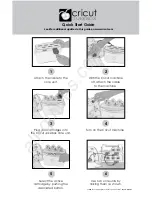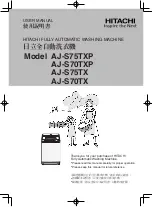
Input/output setting mode
26 WC
When the input signal (WC) is ON, output of the wiper output (W) is prohibited.
[15]-6
Serial
No.
Function
Specifications
27 TC
When the input signal (TC) is ON, the thread trimming operation output [thread
trimming output (T)], [thread release output (L)], and [wiper output (W)] output are
all prohibited.
28 S6
If the input signal (S6) turns ON while the sewing machine is running, the sewing
machine will stop. Operation will resume when the signal is turned OFF.
If the input signal (S6) is turned ON during thread trimming, after the thread is
trimmed, operation will not resume until this input signal (S6) is turned OFF.
29 HPC
When the input signal (HPC) is ON, home position return operations will be
prohibited.
30 --1
Use prohibited
31 THS
When [program/thread breakage sensor mode "needle thread breakage sensor
valid/invalid setting (S1) is ON]:
If the input signal (THS) is input (ON) during sewing, the sewing machine will
halt according to the value set for the number of invalid stitches for the halt
sensor, and a message code [M-21] will appear. (State can be recovered.)
When [program/thread breakage sensor mode "needle thread breakage sensor
valid/invalid setting (S1) is OFF]:
Even if the input signal (THS) is input (ON) during sewing, the sewing
machine will not stop.
32 ARS
If the input signal (ARS) is turned ON during stitching (while the power is ON), the
sewing machine will stop, and the error [ERR-025] will appear. (This state cannot be
recovered. Turn the power OFF.)
33…48 IO0…IOF
When the input signal (IO0) turns ON, the virtual output signal 0 (OT0) will turn ON
at any time. (Same for IO1 to IOF)
49 NO
Nothing will happen even if the input signal NO is turned ON.
50 SRT
When the input signal (SRT) is turned ON, the sewing machine will start stitching.
If the work holder is OFF (raised), this signal will be invalidated.
51 HP
When the input signal (HP) is turned ON, the home position return operation will be
executed. Note that there is an invalid timing, such as when the sewing machine is
running.
52 WID
When the input signal (WID) is turned ON, the mode will change from the [normal
mode] to the [bobbin winding mode].
53 JGP
When the input signal (JGP) is turned ON, the work holder will move (jog) in the
forward direction.
[Same operation as jog key (forward direction) on the panel.]
54 JGM
When the input signal (JGM) is turned ON, the work holder will move (jog) in the
reverse direction.
[Same operation as jog key (reverse direction) on the panel.]
55 STP
When the input signal(STP) is turned ON, the sewing machine will halt.
[Same operation as turning ON the HALT switch on the sewing machine head.]
56 BC
The needle will stop just before the fabric to confirm the position for puncturing the
fabric with the needle. Each time the input signal (BC) is turned ON, the operation
will be repeated in the order of 1. [Forward run] , 2. [Reverse run] , 3. [Forward run].
If the start switch is then turned ON and the next stitching data indicates stitching,
operation will start from that position. If the next stitching data indicates feed data,
M-20 will appear. Raise the needle to the UP position once, and then turn the start
switch ON.
[This can be adjusted with the [needle DOWN angle setting] in the function mode.]
57 CCL
When the input signal (CCL) is turned ON, the counter will be cleared. [Same
operation as [Counter Clear] key.]
The clearing method is determined by the counter mode setting in the program
mode.
58 SRC
When the input signal (SRC) is turned ON, start stitching with the start input signal
(SRT) will be prohibited.
59 CCU
When the input signal (CCU) is turned ON, the up counter will be cleared.
60 CCD
When the input signal (CCD) is turned ON, the down counter will be cleared.
61 UAD
When the input signal (UAD) is turned ON, the up counter will increment by one.
62 UDC
When the input signal (UDC) is turned ON, the up counter will decrement by one.
Summary of Contents for PLK-E Series
Page 2: ......
Page 13: ...Explanations of basic screens keys and operations 3 6...
Page 15: ...Stitching data type and writing No 4 1...
Page 21: ...Reading writing and erasing data floppy disk 5 5...
Page 26: ...Reading writing and erasing data internal memory 6 4...
Page 28: ...7 1...
Page 35: ...Creating simple stitching data 8 6...
Page 39: ...Methods of creating stitching data 9 3...
Page 44: ...Methods of creating stitching data 9 7...
Page 54: ...Methods of creating stitching data 9 15...
Page 58: ...Methods of creating stitching data 9 22...
Page 63: ...Methods of creating stitching data 9 26...
Page 68: ...Methods of creating stitching data 9 30...
Page 72: ...Methods of creating stitching data 9 33...
Page 75: ...Methods of creating stitching data 9 35...
Page 79: ...Methods of creating stitching data 9 38...
Page 86: ...Modification mode 12 5...
Page 89: ...Modification mode 12 7...
Page 94: ...Modification mode 12 11...
Page 99: ...Modification mode 12 15...
Page 104: ...Modification mode 12 19...
Page 111: ...Modification mode 12 25...
Page 115: ...Modification mode 12 28...
Page 122: ...Modification mode 12 34...
Page 126: ...Modification mode 12 37...
Page 133: ...Modification mode 12 43...
Page 138: ...Modification mode 12 47...
Page 143: ...Modification mode 12 51...
Page 148: ...Modification mode 12 55...
Page 155: ...Data conversion mode 13 6...
Page 158: ...Data conversion mode 13 8...
Page 162: ...Data conversion mode 13 11...
Page 166: ...Data conversion mode 13 14...
Page 169: ...Data conversion mode 13 16...
Page 179: ...Data conversion mode 13 25...
Page 204: ...Program mode 16 5...
Page 205: ...Program mode 16 6...
Page 208: ...Program mode list 17 2...
















































